Continuing on my exploration of “trip loot” from my recent vacation, during which I stopped at four popular needlework shops, I thought I’d show you a couple kits I picked up at Nordic Needle. They’re kits for Huck embroidery, also called Swedish Weaving or Huck Darning. I thought they were appropriate to buy at Nordic Needle (considering the “Nordic” angle), and surely, thought I, they would make Really Good Projects to work in the car!
Six thousand miles and almost three weeks later, I’ll admit I never did open up these embroidery kits while I was in the car. In fact, I don’t think I ever looked at them again until I unpacked everything (and that was just briefly)… but while reorganizing this morning and putting things in a “definite” place (you know how it is – from The Stack to the Definite Place?), I came across them again, and thought I’d show them to you.
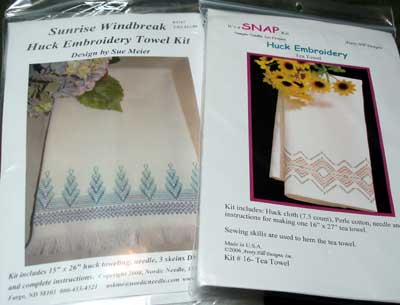
The kits are for two towels, which is a typical (but not the only) application for Huck work.
Strangely enough, though the kits caught my attention at the time, now as I look at them, I find myself chuckling. Neither are in “my” colors! They aren’t really typical of me at all.
Yet, still, I like the idea of them.
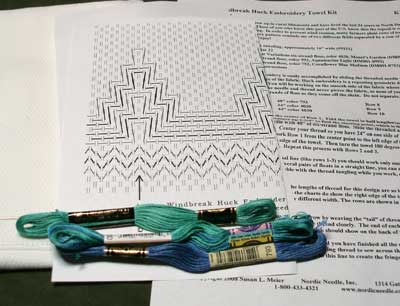
Huck embroidery is worked on a specific type of fabric, normally (at least for beginners, anyway!) by following a pattern like the one in the photo above. The lines of the design represent the floss, while the little vertical dashes speckling the pattern represent the fabric weave.
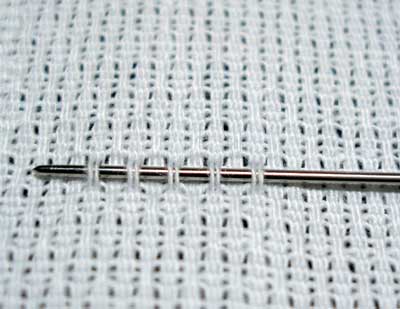
You can use specific fabric for Huck work called Huck fabric, or you can use Huck toweling (or huckaback). You can also get away with using aida cloth or monk’s cloth for Huck embroidery, too. For the actually “weaving” of the design (running the needle under loops of the fabric, according to a pattern, to create stitches that look like darning stitching – hence, “Swedish Weaving” and “Huck Darning”) you use a blunt tapestry needle. And almost any kind of regular cotton embroidery thread or floss can be used, including pearl cotton and stranded cotton.
Those are the tidbits of information I picked up about Huck embroidery in reading the backs of the kits at Nordic Needle. Other than that, I don’t really know much about the technique, as I’ve never tried it!
I’ve relegated these kits to the Someday Pile – I’m interested in trying them, but not right now, as there’s just too much on the plate at the moment!
Still, I thought they were interesting enough to show you the kits, and ask if anyone out there is a great fan of Huck work, and if so, can you tell us any other information about it? Are there links and resources available for this craft? How ’bout some photo pages and so forth?





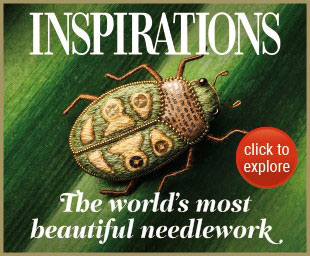
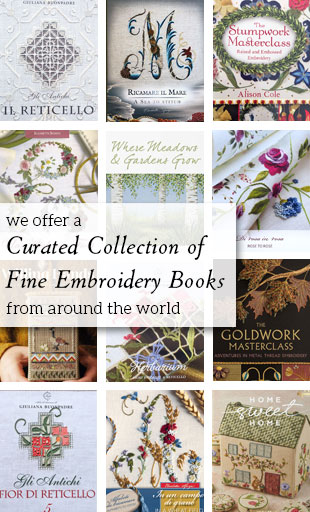
My mother in law gave me yards and yards of monks cloth, so I did a little research on huckwork and found this yahoo group to be a great resource- http://groups.yahoo.com/group/SwedishWeave/
I haven't gotten to making anything yet, but it does seem like a fun thing that you can do a lot with.
I've always liked the looks of huckwork but for me the drawback was having to use a special huck fabric. I just didn't like the idea of that. Only now that you say Aida or Monk's cloth is okay-I happen to have plenty of that on hand! The beauty of it, I think, is the bargello style. There are many of us who adore the flame or Florentine stitching style. Have fun with your kits and of course we can count on you to post, right?! P.S. Are they gifts or will you keep them?
You have brought back some very nice memories with your Huck Kits. Huck embroidery was one of the needlwork projects I learned in Home Ec class (remember when the schools actually taught that!). Admittedly I did not keep up with it but I certainly do remember enjoying it tremendously. Perhaps it's time for me to renew that passion. Thanks for the trip down memory lane.
ME in Ottawa, ON, Canada
p.s. I would like to be able to comment from the newsletter without going into the web site.
My neighbor taught me about this type of needlework years ago. It's easy and fun and the designs can get quite complicated. I made several towels. The one design you shared that looks like aqua colored trees is similar to the one I made for my Mom only I used oranges and rust for her. Cute thing about it is I made her a towel and she uses it to cover and protect her cross stitch work while in progress.
The Huckwork kits brought back fond memories of my grandmother! I remember sitting & doing towels with her using this stitching! I have forgotten most of the names of the stitching designs she taught me as I am 63 now & she started teaching me when I was 7. She passed away at age 95 & I still have several of her embroidery pieces & crocheted doilies. My sisters crochet & knit but mine never came out right! Thanks for reviving fun memories!
I have been making and teaching huck embroidery for over 20 years- we make prayer shawls, tallesim or challah covers. I learned from my friend Ellen Temkin who pioneered the technique for a prayer shawl and challah cover. She designed some unique Jewish stitches that I have been using and modifying over the years. I teach in Ridgefield,CT if anyone is interested- I may be making a book of Jewish Huck Embroidery if anyone has suggestions- please email me-
cantordkg@aol.com
THANKS
Cantor Debbie Katchko-Gray
Ridgefield,CT
I too learnt the craft of Huck embroidery as a child and like many of your other folk, I am nearly 60. I loved doing it and kept my eyes out for decades to buy the fabric – but could never find it – I even started to think that maybe I had never done it. But then, we lived for a while in the Middle East and it wasn't long before I found myself teaching Huck Embroidery to Primary School children – using Aida cloth. I have since bought the "real" fabric and have it in my stash – but haven't gotten around to using it yet. I encouraged the childen to make tray cloths as a project and they worked a treat.
2009 … well, I’m a bit late in seeing and commenting!
In 2000, I found the http://groups.yahoo.com/group/SwedishWeave/
but didn’t get into it until Spring 2001.
My first afghan was on Monk’s cloth (7 sts per inch) and worsted yarn using a flat needle called ‘bodkin’ … you can see some of my SW / Huck on http://Gentleasyougo.eboard.com and also http://SandrasStitches.eboard.com
Both types are easy to do … all depending on the density of the patterns. A regular afghan is about 2-1/2 yards of fabric, for instance. A baby size would be substantially less.
Of course, then each person has to figure out whether they want to use yarn/Monk’s cloth or floss/perle on Aida or Huck fabrics.
I’ve done counted cross stitch and SW on fingertip towels — also can be seen on my eBoard.
Thank you, Mary, for the different sites you find for us.
Hello, I have been doing Huck embroidery for years and luckily I was given a lot of huck material. It is extremely to find in Australia.
The small huck is nicest finished but I have maybe a medium size loops. I have done designs from books and have entered in shows. Judges do not know about Huck so ignore my entries.
I would love to see more designs as I am going to make a runner to enter in our show on the 29th July.
I live in North West of Queensland in Charters Towers.
Regards,
Dawn
You can swap out the colors of three for colors you like or that go with your decor. Swedish weaving is a fun and simple project. I have a throw blanket started. I would like to make a table runner. Once you get the hang of it and your pattern down, it becomes routine and simple. I can do a row or two and then not have to look at my pattern or really count anymore. The blanket I am doing repeats. Nordic Needle is an awesome shop, and their staff is very helpful.
SandrasStitches – she is an amazing designer and colorways artist. She sells via Monksclothandmore …
I have yards of Monk’s Cloth – and have actually started and finished a very dense and intense pattern by Sandra. The finished afghan looks like a chevron ripple crochet afghan.
This is a medium that young children (boys and girls) can do – and it’s easy to design your own patterns.
I like using a flat bodkin when using worsted yarn on Monk’s Cloth. But each SWr has their own preference – Sandra likes using a bend tip flat bodkin.
Floss/perle cotton is used with a blunt needle when the fabric is Aida or Huck toweling. Both methods show only on the front, although with Monk’s cloth some of the back will show a bit of the yarn, depending on one’s tension.
Monk’s Cloth MUST be prepared by zigzag around the edges BEFORE washing and drying – this cloth is 100% cotton and will shrink approximately 15-20%. Use only acrylic yarns. Open work can be done, especially around the edges. Fringe can be added or self-fringe.
The Center is found and then, depending on the width of the fabric, and the complexity of the design, each row is done with 1 continuous piece of yarn – starting from the Center float, working half of the yarn in one direction to the edge and then the second half of the yarn in the opposite direction. Doing it from edge to edge will cause a warp of the fabric.
An adult afghan would be 2.5 yards of Monk’s Cloth — and my suggestion is to start small – with placemats, for instance.
The zigzag stitching around the edges is mandatory. Do NOT wash without doing that first step.
Ok ‘nuf said. Swedish Weaving is actually very addictive – and easy to do on either type of fabric.
The process on a prefinished towel is a good idea, too. A skein of floss goes a very long way – as does a skein of yarn for the Monk’s Cloth.
Monk’s Cloth is approximately 7 floats to an inch – and Aida has more floats.
Hello, in browsing your web site, I saw the Huck Towel kits and was wondering if you sold those kits and how much is the cost. Thank you, Geri
Hi, Geri – they’re available from Nordic Needle online. Hope that helps!
Is there anyway I can get a copy of Pralines and Cream Avery Hills Designs- Embroidery for Ducks pattern ?
Nordic Needle is no longer active online. Im looking for Huck fabric. All sites visited, all stores visited. Selling Monk’s cloth, or Aida cloth is NOT the same. Is there any site I can search it out? Lacis.com is out of business, trishalandesigns.blogspot.com doesn’t have it, Spoonflower, not….JoAnns, no, Walmart, no, Hobby Lobby, no, Michaels, no, Etsy, no, Ebay, no, Dr. Joe, no, and certainly not Amazon. They all sell Monks cloth, and that’s not what Im looking for. Mw.
I have done Swedish weaving on Monk’s cloth, but have never seen it done with embroidery threads. If you think you’d be willing to sell these 2 kits to me, please advise. Thank you.
My Aunt passed and I found some emb and I think she called it huck emb but it is already printed on, is that possible. So I’m asking for some help and how to do it. What do I need to do. Help
Sharon
I recently tried huck weaving. In fact, I’m helping to teach it at the local library. It’s very easy and very addictive. I knit, crochet, quilt and embroider, but right now I’m hooked on huck. It’s very hard to find a good quality of huck fabric. If it gains in popularity, perhaps the fabric will too.
Try it, you’ll love it !
Huck weaving is loads of fun – it’s pretty simple and it is, as you say, addictive – there’s something about watching the pattern grow that’s just fascinating!
I found your site and enjoy scrolling through. I like the way you share needlework from all over the world!